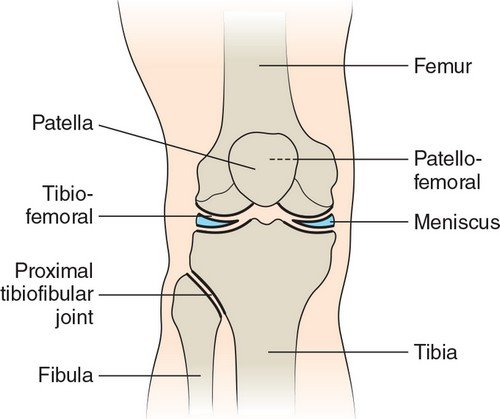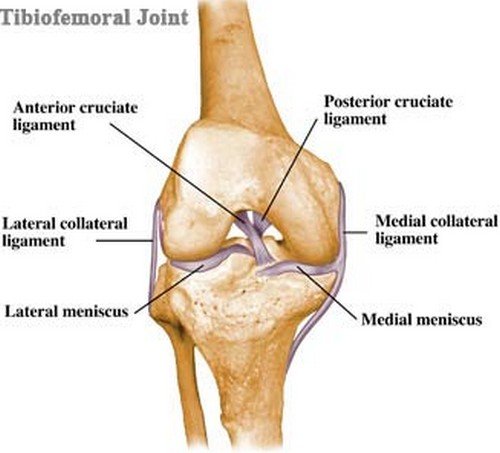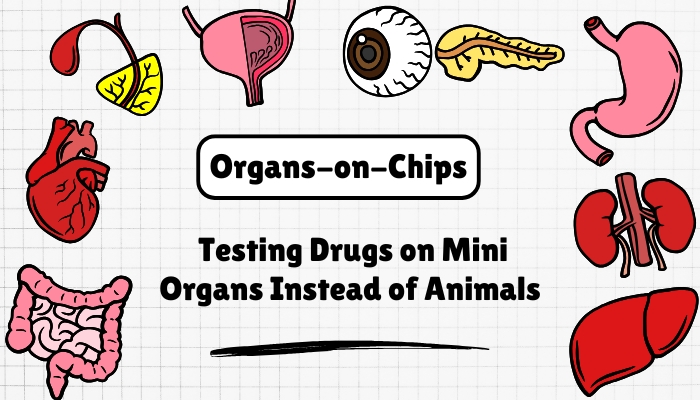The knee joint allows you to extend and flex the legs. It is a bicondylar type synovial joint. It is surrounded by joint capsule with ligaments strapping inside and outside of the joint.
The ligaments that run along the sides of the knee are called collateral ligaments. They limit the sideways movement of the knee. The ligament that connects the tibia to the femur at the center of the knee is called anterior cruciate ligament (ACL).
Its role is to limit the forward movement and rotation of the tibia. The ligament behind the ACL is called posterior cruciate ligament (PCL). Its role is to limit the backward movement of the tibia. (1, 2)
There are three primary bones in the knee, the femur (thigh bone), tibia (shin bone), and patella (knee cap). A layer of cartilage covers the ends of the bones. It is the same material that absorbs shock and lets the bones in the knee glide easily as they move. In between the tibia and femur are crescent-shaped pads of cartilage.
Their function is to equally divide the weight of the body across the joints and reduce friction. These cartilages are lateral meniscus and medial meniscus. A joint capsule holds the bones together.
There are two layers; the inner membrane (synovium) and the outer layer, which are supported by ligaments and tendons such as quadriceps tendon, medial collateral ligament, lateral collateral ligament, anterior cruciate ligament, and posterior cruciate ligament.
There are two muscle groups supporting the knee. These are the hamstrings and quadriceps. Hamstrings are muscles found at the back of the thigh while the quadriceps are muscles in front of the thigh. (1, 2,3)
 Image 1: The anatomical presentation of the knee
Image 1: The anatomical presentation of the knee
Picture Source:fadavispt.mhmedical.com
 Photo 2: A closer look at the tibiofemoral joint.
Photo 2: A closer look at the tibiofemoral joint.
Picture Source: www.askthetrainer.com
Knee Joint Articulations
- Tibiofemoral – It is the middle and lateral condyles of the femur that articulates with the tibia. The tibiofemoral joint is also known as the weight-bearing joint. Its primary rotary motion is flexion and extension. The tibiofemoral joint connects the tibia to the femur. It is known as the hinge joint.
- Patellofemoral – It is in the anterior and distal portion of the femur that articulates with the patella. It is known as the gliding joint. (3, 4)
The knee joint is classified as synovial joint because it is a freely movable joint. It is a uniaxial joint because it moves only in one plane, but can be slightly rotated. Just like the elbow, the knee is a hinge joint.
You can easily bend and straighten it. As the knee moves, it slightly rotates. For the knee joint to move, it needs help of the thigh muscles such as the quadriceps and hamstrings. However, for these muscles to perform their task, they need help from tendons (tough cord of tissues connecting the muscles to the bones). (4)
If you extend the leg, the quadriceps muscle contracts thereby pulling the quadriceps tendon. It will then pull the patellar tendon causing the knee to extend. The hamstring muscle is at the posterior side of the knee.
It is the muscle responsible for flexion of the knee. What is the primary movement of the knee joint? Its primary movements are flexion and extension of the legs. It lets you walk, jump, run, and climbs easily. Any problem of the knee joint can surely affect your mobility. (5, 6)
Knee-related problems
The knee is prone to trauma, stress, and injury, especially for people who are into contact sports. A pain in the knee area is one of the clinical manifestations of knee-related problems. Usually, the patient complains of a sharp pain.
The degree and type of pain vary from one person to another. To some, the pain is constant while to others, the pain is on and off. Some knee problems heal with rest and cold compress. Others need knee rehabilitation therapy. In severe cases, a knee surgery is needed. (6)
Swelling of the knee
There is a localized swelling. It can be associated with excessive production of synovial fluid or bleeding in the joint. If it is caused by bleeding, the swelling occurs within the first hour of the injury. On the other hand, swelling caused by too much production of synovial fluid occurs t2 to 24 hours.
Swelling in the knee can be very painful and affects your full range of motion. The patient is strongly advised to rest and apply cold compress on the affected knee. (10)
Locking of the knee
If you can’t fully straighten out your knee, then there is most likely a loose body in the knee. Through arthroscopic procedure, the loose body is removed. If the knee hurts so bad that you can’t use it, then you are strongly advised to take a rest and put some ice on the affected knee. (7, 8)
Unstable knee
Do you feel like your knee can’t support your weight? If you feel like your knee is unstable, it probably is because the kneecap slips out of its groove. A feeling of unstable knee can also be caused by weak muscles of the legs or can be exacerbated by a previous ligament injury. (9, 10)
Noise coming from the knee
Do you hear a crack, pop, or snap from your knee? If it is painless, then there is really nothing to worry about. It could just be loose bodies floating around. However, you should immediately see your doctor if you experienced pain and swelling. It could indicate an injury, dislocated kneecap, or degenerative diseases like osteoarthritis. (8)
Pathological conditions affecting the knee
- Osteoarthritis
- Infectious arthritis
- Gout
- Rheumatoid arthritis
Traumatic Knee Injuries
Knee injuries are common in people who have active lifestyle such as those in the sports activities. The most common knee injury is ACL (anterior cruciate ligament) tear. ACL plays an important role in the stability of the knee.
A tear in the anterior cruciate ligament causes the knee to buckle or give out. Basketball players and runners commonly experience ACL tear. The extent of the tear is assessed. A surgical repair is needed in people with serious ACL tear. Other traumatic knee injuries include meniscus tear, injury involving the lateral and medial collateral ligament, and the posterior cruciate ligament injury. (8, 9,10)
References:
- www.msdmanuals.com
- www.emedicinehealth.com
- www.orthopaedicsone.com
- www.uptodate.com
- www.orthobullets.com
- https://en.wikipedia.org
- www.mayoclinic.org
- www.healthpages.org
- www.ncbi.nlm.nih.gov
- Joint Structure and Function: A Comprehensive Analysis By Pamela K Levangie, Cynthia C Norkin



